S & S Special Grumman F6F-5 Hellcat Video
|
|
|
|
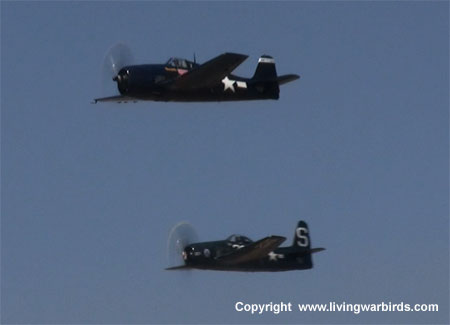 |
Manufacturer: Grumman Model: F6F-5 Year built: 1944 (Original) Serial Number: 27354801-66 Number of Seats: 2 Number of Engines: 1 Engine Type: Reciprocating Engine: P&W R-2800 Series |
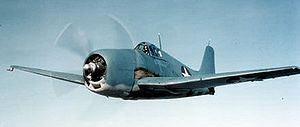 Role: Fighter aircraft
Role: Fighter aircraft
Manufacturer: Grumman
First flight: 26 June 1942
Introduced: 1943
Retired: 1954, USN
Primary users: United States Navy, United States Marine Corps, Royal
Navy, French Navy
Produced: 1942-1945
Number built: 12,275
Unit cost: $35,000 in 1945
The Grumman F6F Hellcat was a United States Navy carrier based fighter aircraft developed to replace the earlier F4F Wildcat. Although the F6F bore a family resemblance to the Wildcat, it was a completely new design powered by a 2,000 hp Pratt & Whitney R-2800. Some tagged it as the "Wildcat's big brother". The Hellcat and the Vought F4U Corsair were the primary USN fighters during the second half of World War II.
The Hellcat proved to be the most successful aircraft in naval history, destroying 5,171 aircraft while in service with the U.S. Navy and U.S. Marine Corps (5,163 in the Pacific and eight more during the invasion of Southern France), plus 52 with the Royal Navy's Fleet Air Arm during World War II. Postwar, the Hellcat aircraft was systematically phased out of front line service, but finally retired as late as 1954 as a night-fighter in composite squadrons.
Design and development
 (Image: Grumman F6F-3 Hellcats in tricolor camouflage, red outline on
US insignia indicate picture was taken circa June - September 1943)
(Image: Grumman F6F-3 Hellcats in tricolor camouflage, red outline on
US insignia indicate picture was taken circa June - September 1943)
Grumman was working on a successor to the F4F Wildcat well before the Japanese attacked Pearl Harbor. While the F4F was a capable fighter, early air battles revealed the Japanese A6M Zero was more maneuverable and possessed a better rate of climb than the F4F. The F4F did have some advantages over the Zero. Wildcats were able to absorb a tremendous amount of damage compared to the Zero, and had better armament. The F4F was also much faster in a dive than the Zero, an advantage Wildcat pilots used frequently to elude attacking Zeros.
 (Image: F6F-5 ready in catapult on USS Randolph)
(Image: F6F-5 ready in catapult on USS Randolph)
These advantages carried over into the F6F and, combined with other improvements, created a fighter that outclassed the Zero almost completely. The contract for the prototype XF6F-1 was signed on 30 June 1941. The F6F was originally to be given the Wright R-2600 Cyclone engine of 1,700 hp (1,268 kW), but based on combat experience of F4F Wildcat and Zero encounters, Grumman decided to further improve their new fighter to overcome the Mitsubishi Zero's dominance in the Pacific theater. Grumman installed the Pratt & Whitney R-2800 Double Wasp 2,000 hp (1,500 kW) estimating a 25% increase in performance would result. The first Cyclone-equipped prototype (02981) flew on 26 June 1942 while the first Double Wasp-equipped aircraft, the XF6F-3 (02982) had its first flight on 30 July 1942.
Proposed at the same time as the first Hellcat prototypes, the XF6F-2 incorporated a turbo-supercharger, but performance gains were only slight and until fleet demands for improvements in speed arose, this variant, along with the two-speed supercharger-equipped XF6F-3, languished. However, later F6F-4 and F6F-5 variants did benefit from these initial development programs.
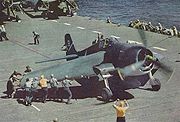 (Image: Grumman F6F-3 Hellcat on the flight deck of USS Yorktown (CV-10)
prior to take off, having its wings extended)
(Image: Grumman F6F-3 Hellcat on the flight deck of USS Yorktown (CV-10)
prior to take off, having its wings extended)
Like the Wildcat, the Hellcat was designed for ease of manufacture and ability to withstand significant damage. A total of 212 lb (96 kg) of cockpit armor was fitted to aid pilot survival, as well as a bullet-resistant windshield and armor around the engine oil tank and oil cooler. Self-sealing fuel tanks further reduced susceptibility to fire and often allowed damaged aircraft to return home. The U.S. Navy's all-time leading ace, Captain David McCampbell USN (retired) scored all his victories in the Hellcat. He once described the F6F as "...an outstanding fighter plane. It performed well, was easy to fly and was a stable gun platform. But what I really remember most was that it was rugged and easy to maintain."
The first production aircraft off the line, designated F6F-3s, flew on 3 October 1942 with the type reaching operational readiness with VF-9 on USS Essex in February 1943.
Two night fighter subvariants of the F6F-3 were also developed. The F6F-3E, converted from standard -3 frames, featured the AN/APS-4 radar in a fairing in the starboard wing. The later F6F-3N, first seen in July 1943, was fitted with the AN/APS-6 radar in a similar fairing. By November 1943, Hellcat night fighters had seen their first action. Fitting AN/APS-6 radar fairings to F6F-5s resulted in the night fighter F6F-5N, and a small number of standard F6F-5s were also fitted with camera equipment for reconnaissance duties as the F6F-5P.
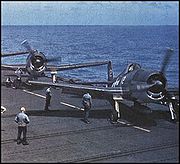 (Image: Grumman F6F-3 Hellcats in tricolor scheme on the flight deck)
(Image: Grumman F6F-3 Hellcats in tricolor scheme on the flight deck)
Instead of the Wildcat's narrow-track undercarriage retracting into the fuselage requiring awkward hand-cranking by the pilot, the Hellcat had hydraulically-actuated undercarriage struts set wider and retracting backward, twisting through 90° into the wings, exactly as the Chance Vought F4U Corsair's landing gear did. The wing was low-mounted instead of mid-mounted and folded the same way as the later versions of the Wildcat, allowing the Hellcat to take on a compact, tucked-in appearance on a flight deck
Standard armament on the F6F consisted of six .50 caliber (12.7mm) Browning M2/AN air-cooled machine guns with 400 rounds each; later aircraft gained three hardpoints to carry a total bombload in excess of 2,000 lbs. (900 kg). The center hardpoint also had the ability to carry a single 150 U.S. gallon (568 L) disposable drop tank. Six 5 in. (127 mm) HVARs (High Velocity Aircraft Rocket) could be carried; three under each wing.
The next and most common variant, the F6F-5, featured improvements such as a more powerful R-2800-10W engine housed in a slightly more streamlined engine cowling, spring-loaded control tabs on the ailerons, deletion of the rear-view windows behind the main canopy, an improved, clear view windscreen with a flat armored-glass front panel replacing the curved perspex panel and internal armor glass screen and numerous other minor advances. Another improvement in the F6F-5 was the availability of more potent armament than the standard six .50 caliber (12.7 mm) machine guns. Trials with cannon-armed Hellcats were not followed up by a production version; although all F6F-5s could carry an armament mix of a pair of Hispano 20mm (0.79 in.) cannon, one mounted in each of the inboard gun bays, with a minimum of 220 rounds per gun, along with two pairs of .50 caliber (12.7 mm) machine guns, with 400 rounds per gun, this configuration was only used on many later F6F-5N night fighters.
Two F6F-5s were fitted with the 18-cylinder 2,100 hp (1,567 kW) Pratt and Whitney R-2800-18W two-stage blower radial engine which was also used by the F4U-4 Corsair. The new Hellcat variant was fitted with a four-bladed propeller and was called the XF6F-6. The aircraft proved to be the best performer in the series with a top speed of 417 mph. Plans for mass production of this variant were cancelled with the advent of VJ day.
The last Hellcat rolled out in November 1945, the total production figure being 12,275, of which 11,000 had been built in just two years. This impressive production rate was credited to the sound original design, which required little modification once production was underway.
Operational history
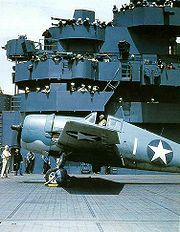 (Image: Grumman F6F-3 Hellcat on the USS Yorktown (CV-10) in late 1942.
Non-specular blue-grey over light-grey scheme)
(Image: Grumman F6F-3 Hellcat on the USS Yorktown (CV-10) in late 1942.
Non-specular blue-grey over light-grey scheme)
The Hellcat first saw action against the Japanese on 1 September 1943 when fighters off the USS Independence (CVL-22) shot down a Kawanishi H8K "Emily" flying boat. Soon after, on 23 and 24 November, Hellcats engaged Japanese aircraft over Tarawa, shooting down a claimed 30 Mitsubishi Zeros for the loss of one F6F. Over Rabaul, New Britain, on 11 November 1943, Hellcats and Corsairs were engaged in day-long fights with many Japanese aircraft including A6M Zeros, shooting down nearly 50 aircraft. Hellcats also utilized the "Thach Weave", which had been developed into a formation tactic to compensate for the older F4F Wildcat's deficiencies.
Hellcats were involved in practically all engagements with Japanese air power from that point onward. It was the major U.S. Navy fighter type involved in the Battle of the Philippine Sea, where so many Japanese aircraft were shot down that Navy aircrews nicknamed the battle The Great Marianas Turkey Shoot. The F6F accounted for 75% of all aerial victories recorded by the U.S. Navy in the Pacific. Radar-equipped Hellcat night fighter squadrons appeared in early 1944.
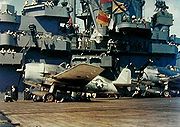 (Image: USS Yorktown (CV-10) during the Marcus Island raid on 31 August
1943: CAG-5 Lt. Cmdr. "Jimmy" Flatley in his F6F-3 Hellcat
before takeoff. Aviation Boatswain Mate stands ready to remove chock
from wheels. Early, improvised scheme of non-specular sea-blue and intermediate
blue over white)
(Image: USS Yorktown (CV-10) during the Marcus Island raid on 31 August
1943: CAG-5 Lt. Cmdr. "Jimmy" Flatley in his F6F-3 Hellcat
before takeoff. Aviation Boatswain Mate stands ready to remove chock
from wheels. Early, improvised scheme of non-specular sea-blue and intermediate
blue over white)
Navy and Marine F6Fs flew 66,530 combat sorties (45% of all fighter sorties of the war, 62,386 sorties were flown from aircraft carriers) and destroyed 5,163 (56% of all Naval/Marine air victories of the war) at a cost of 270 Hellcats (an overall kill-to-loss ratio of 19:1). The aircraft performed well against the best Japanese opponents with a 13:1 kill ratio against Mitsubishi A6M, 9.5:1 against Nakajima Ki-84, and 3.7:1 against Mitsubishi J2M during the last year of the war. The F6F became the prime ace-maker aircraft in the American inventory, with 306 Hellcat aces. That being said, it must be noted that the U.S. successes were not only attributed to superior aircraft, but also because they faced increasingly inexperienced Japanese aviators from 1942 onwards, as well as having the advantage of ever-increasing numerical superiority.
In the ground attack role, Hellcats dropped 6,503 tons of bombs.
The British Fleet Air Arm received 1,263 F6Fs under the Lend-Lease Act and dubbed it Gannet I. The name Hellcat was eventually retained in early 1943 for the sake of simplicity, as the Royal Navy at that time adopted the use of the existing American naval names for all the U.S.-made aircraft supplied to it, with the F6F-3 being designated Hellcat F I, the F6F-5, the Hellcat F II and the F6F-5N, the Hellcat NF II. They saw action off Norway, in the Mediterranean and in the Far East. A number were fitted with photographic reconnaissance equipment similar to the F6F-5P, receiving the designation Hellcat FR II. The FAA Hellcat units experienced far fewer opportunities for air-to-air combat than their USN/Marines counterparts; a total of 52 enemy aircraft were shot down during 18 aerial combats from May 1944 to July 1945. 1844 Squadron FAA, on board HMS Indomitable of the British Pacific Fleet was the highest scoring unit, with 32.5 kills.
 (Image: Grumman F6F-3 Hellcats on the flight deck with wings folded,
Grumman Avenger on landing approach)
(Image: Grumman F6F-3 Hellcats on the flight deck with wings folded,
Grumman Avenger on landing approach)
FAA Hellcats, as with other Lend-Lease aircraft, were rapidly replaced by British aircraft after the end of the war, with only two of the twelve squadrons equipped with the Hellcat at VJ-Day still retaining Hellcats by the end of 1945. These two squadrons were disbanded in 1946. In British service, the Hellcats proved to be a match even for the main Luftwaffe fighters, the Messerschmitt Bf 109 and Focke-Wulf Fw 190.
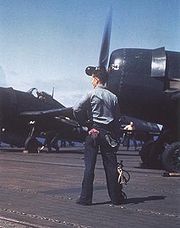 (Image: Aircraft captains ready VF-82 Grumman F6F-5 for launch from
USS Bennington (CV-20) off Okinawa in May 1945. Late-war production F6F-5
show the overall Glossy Sea Blue)
(Image: Aircraft captains ready VF-82 Grumman F6F-5 for launch from
USS Bennington (CV-20) off Okinawa in May 1945. Late-war production F6F-5
show the overall Glossy Sea Blue)
Postwar, the Hellcat was succeeded by the Grumman F8F Bearcat which was smaller than the Wildcat yet more powerful and more maneuverable than the Hellcat, but came online too late to see combat in World War II. The Hellcat soldiered on in a number of second line USN duties including training. The French Aéronavale was equipped with F6F-5 Hellcats and used them in Indochina. The Uruguay Navy also used them until the early 1960s.
Specifications (F6F-5 Hellcat)
General characteristics
Crew: 1
Length: 33 ft 7 in (10.24 m)
Wingspan: 42 ft 10 in (13.06 m)
Height: 13 ft 1 in (3.99 m)
Wing area: 334 ft² (31 m²)
Airfoil: NACA 23015.6 mod root; NACA 23009 tip
Empty weight: 9,238 lb (4,190 kg)
Loaded weight: 12,598 lb (5,714 kg)
Max takeoff weight: 15,415 lb (6,990 kg)
Powerplant: 1× Pratt & Whitney R-2800-10W "Double Wasp" two-row radial engine with a two-speed two-stage supercharger, 2,000 hp (1,491 kW)
Propellers: 3-blade Hamilton Standard
Propeller diameter: 13 ft 1 in (4.0 m)
Fuel capacity: 250 U.S. gal (946 L) internal; up to 3x 150 U.S. gal (568 L) external drop tanks
Zero-lift drag coefficient: 0.0211
Drag area: 7.05 ft² (0.65 m²)
Aspect ratio: 5.5
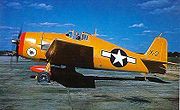 (Image: Postwar service: A bright orange F6F-3K target drone)
(Image: Postwar service: A bright orange F6F-3K target drone)
Performance
Maximum speed: 330 knots (380 mph, 610 km/h)
Stall speed: 73 knots (84 mph, 135 km/h)
Combat radius: 820 nm (945 mi, 1,520 km)
Ferry range: 1,330 nm (1,530 mi, 2,460 km)
Service ceiling 37,300 ft (11,370 m)
Rate of climb: 3,500 ft/min (17.8 m/s)
Wing loading: 37.7 lb/ft² (184 kg/m²)
Power/mass: 0.16 hp/lb (260 W/kg)
Time-to-altitude: 7.7 min to 20,000 ft (6,100 m)
Lift-to-drag ratio: 12.2
Takeoff roll: 799 ft (244 m)
Armament
Guns:
either 6× 0.50 in (12.7 mm) M2 Browning machine guns, with 400 rounds/gun, (All F6F-3, and most F6F-5)
or 2× 20 mm cannon, with 225 rounds/gun
and 4× 0.50 in (12.7 mm) Browning machine guns with 400 rounds/gun (F6F-5N only)
Rockets:
6 × 5 in (127 mm) HVARs or
2 × 11¾ in (298 mm) Tiny Tim unguided rockets
Bombs: up to 4,000 lb (1,800 kg) full load, including:
Bombs or Torpedoes:(Fuselage mounted on centreline rack)
1 × 2,000 lb (910 kg) bomb or
1 × Mk.13-3 torpedo;
Underwing bombs: (F6F-5 had two additional weapons racks either side of fuselage on wing centre-section)
1 × 1,000 lb (450 kg) or
2 × 250 lb (110 kg)
6 × 100 lb (45 kg)
Source: WikiPedia